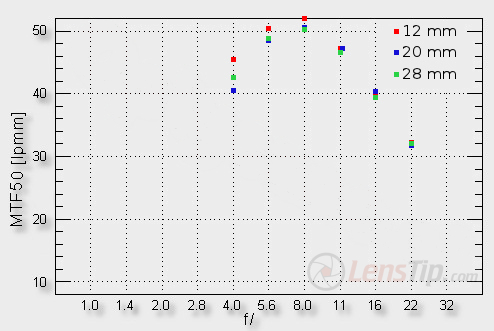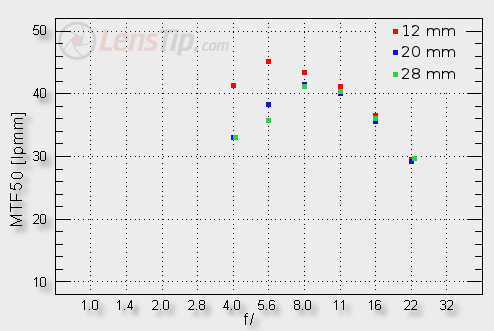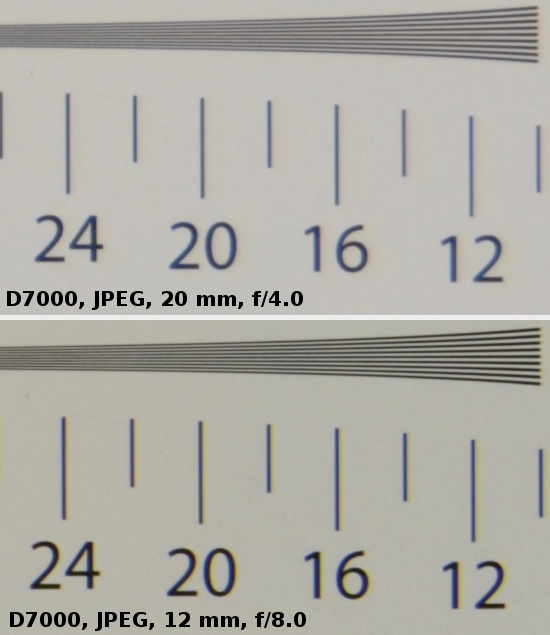Tokina AT-X PRO DX 12-28 mm f/4
4. Image resolution
Let’s check how the tested Tokina fares in the frame centre. The results at 12, 20 and 28 mm are presented on a graph below.

Please Support UsIf you enjoy our reviews and articles, and you want us to continue our work please, support our website by donating through PayPal. The funds are going to be used for paying our editorial team, renting servers, and equipping our testing studio; only that way we will be able to continue providing you interesting content for free. |
- - - - - - - - - - - - - - - - - - - - - - - - - - - - - - - - - - - - - - - - - - - - - - - -
No reservations here - already at the maximum relative aperture the lens gets satisfying results. The weakest combination is that of f/4.0 and 20 mm focal length but even there the MTFs exceed slightly the value of 40 lpmm, making the images useful. On stopping down by 1-2 EV the lens reaches near 50 lpmm. The highest resolution value, that of 52 lpmm, the tested lens gets at the shortest focal length and by f/8.0.
In the case of the Tokina 12-28 mm you don’t get any records but it would be foolish to expect them for two reasons. Firstly the focal range is wider than that of its competitors of 12-24 mm class so there are more difficulties when it comes to the optics design and aberrations corrections. Secondly the lens features f/4.0 aperture and most of lenses reach their maximum results by that aperture speed exactly, but only if it isn’t their maximum relative aperture, where the influence of optical aberrations can still be felt. As you see, for obvious reasons the Tokina cannot break resolution records by f/4.0. It is important, though, that the images it provides across the focal range and in the frame centre, can satisfy even more demanding users.
Let’s check how the situation looks on the edge of the frame. An appropriate graph is presented below.

Definitely the 12 mm focal length presents itself the best. It is obvious the constructors saw to it and indeed, they did a good job – already near the maximum relative aperture the image is decent at least, sometimes even of good quality.
At longer focal lengths the situation is noticeably worse - you have to close down the aperture to near f/6.3-7.1 in order to get a satisfying image. A weak performance at the longer end and the maximum relative aperture doesn’t make us happy; still if the constructors had to reach a compromise I suppose they’ve chosen well. In such type of a lens the 12 mm focal length should be the most even across the frame; the 28 mm, getting close to a standard lens, can be forgiven some blur on the edges which in many situations disappears anyway, falling outside the depth of field area.
Our overall assessment of the tested lens in this category is positive. The new Tokina gets results very similar to those of its 12-24 mm predecessor, providing a wider focal range at the same time. It’s worth mentioning that it also performs better than the Nikkor 12-24 mm or the Tamron 10-24 mm.
At the end of this chapter we present crops of our resolution testing chart, taken from JPEG files saved along RAW files, used for the analysis above.
 |






